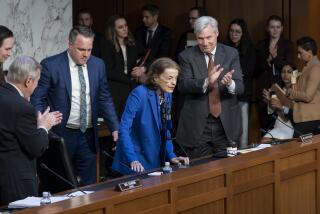This Girl Just Wanted to Have Fun
- Share via
Winston Churchill, Edward R. Murrow, Prince Aly Khan, Giovanni Agnelli, Stavros Niarchos, Averell Harriman. Famous men certainly, but in the great drama that is the life of Pam, they were little more than supporting players.
From pudgy London debutante to Democratic kingmaker--and now U.S. ambassador to France-- Pamela Churchill Harriman for decades shared the spotlight with the important men around her. Only recently has the legendary femme fatale emerged as a shrewd and independent world-class power broker.
In “Reflected Glory: The Life of Pamela Churchill Harriman” (Simon & Schuster), biographer Sally Bedell Smith uses interviews with 400 of her subject’s closest friends and relatives to describe the woman behind all that bold blond charm.
*
On her ability to juggle many men simultaneously:
“Even as she was going with Murrow, Pamela was having affairs with several other men. Around the time of [her lover] Jock Whitney’s departure from London, Pamela began sleeping with Maj. Gen. Fred Anderson, the top American bombing commander, whose views she had been diligently transmitting to her father-in-law [Winston Churchill]. . . . ‘Pam liked to go around with men, and she liked sex and she was attractive,’ explained one American journalist. The American men gave her the nicknames ‘Porcupine’ and ‘Spam,’ but her lovers were ‘reasonably discreet.’ ”
*
On Pamela’s reputation:
In Paris: “One evening in 1954, Liliane [Rothschild] was seated at a dinner next to the Duke of Windsor, who turned to her and said, ‘Which Rothschild is the lover of Pamela Churchill?’ ‘My husband, sir,’ replied Liliane.”
In Washington: “Susan Mary Alsop, dined out, sotto voce, on the details of Pamela’s history as a courtesan. Alsop’s husband, Joseph, the influential journalist and host, ‘accepted Pam with harrumphing and nasty asides.’ Kay Halle, who had lost two men to Pamela--Churchill and Harriman--publicly bore no resentment. ‘There are women men adore and others men don’t,’ she said.”
*
On PamPAC:
“Pamela’s initial reason for launching a political action committee may have been to please her husband, but the real point of PamPAC was Pamela. . . . She had, in a sense, been preparing for the role her whole life. The skills she used on her lovers--the energy, the focus, the follow-through--would now be applied to the Democratic Party. . . .
“Pamela was a master at gathering and spending other people’s money, but curiously [for two years] she didn’t contribute a cent to PamPAC. [Yet] because the PamPAC offices were located on their property, the Harrimans received reimbursements from the Democrats. [In one year], for example, they donated $10,000 to the committee but they received $21,179--in effect making a profit of $11,179 on their political activities.”
*
On the widow-to-be’s preparations for the death of her third and (so far) last husband:
“In April [three months before Averell Harriman’s death], Pamela decided that her husband would have a state funeral in New York as well as a memorial service at the National Cathedral in Washington. [Her assistant] already had a file of information on important funerals [and had] prepared three ‘funeral notebooks’ filled with invitation lists, phone numbers (divided in A, B, C, and D lists), seating plans for the services, table-seating charts for the receptions and the makeup of the military guard. Some staff members were discomfited when they had to call the offices of senators, governors, and diplomats to find their whereabouts in case Harriman died. On Capitol Hill, these inquiries were known as the ‘get out the dead vote calls.’ ”

